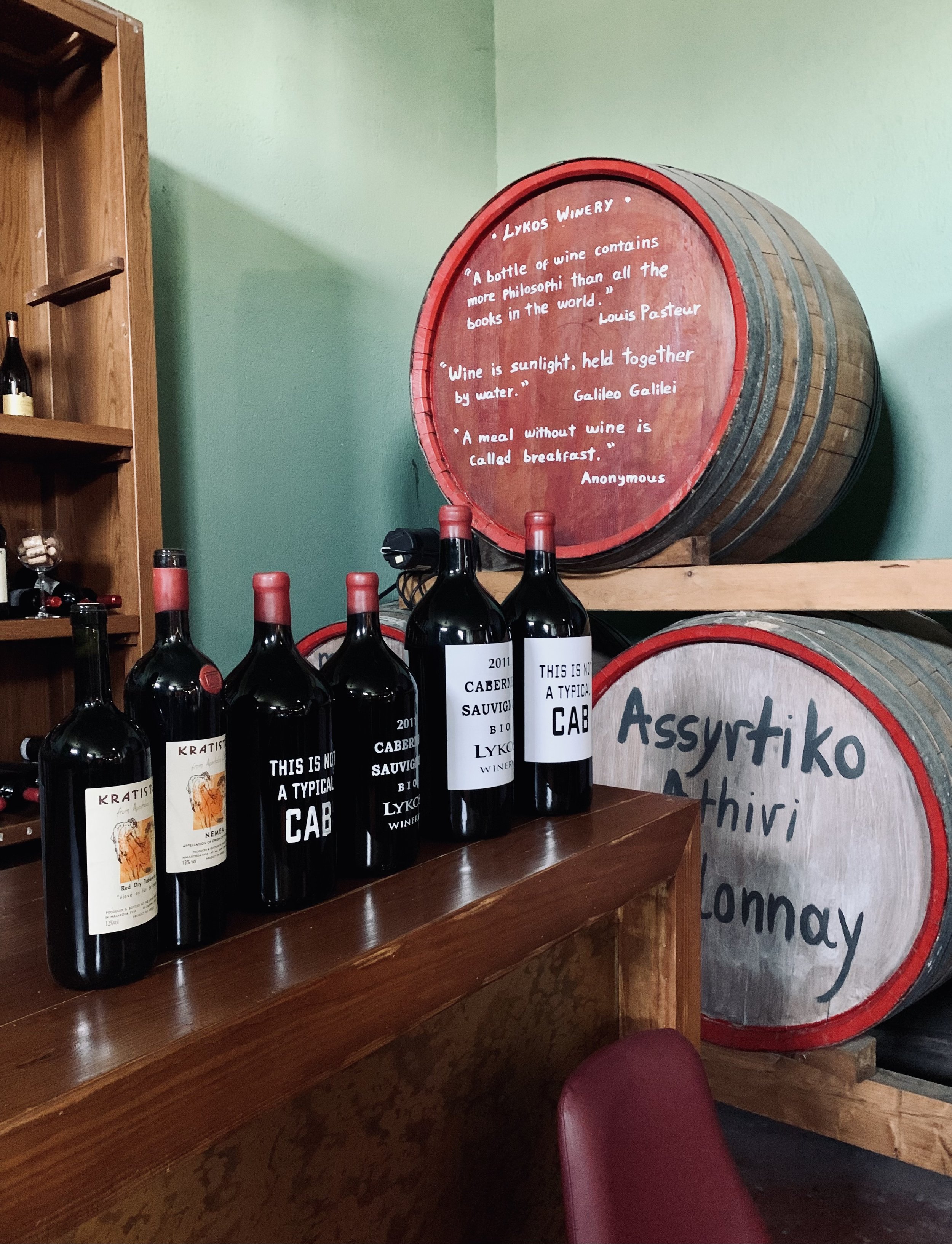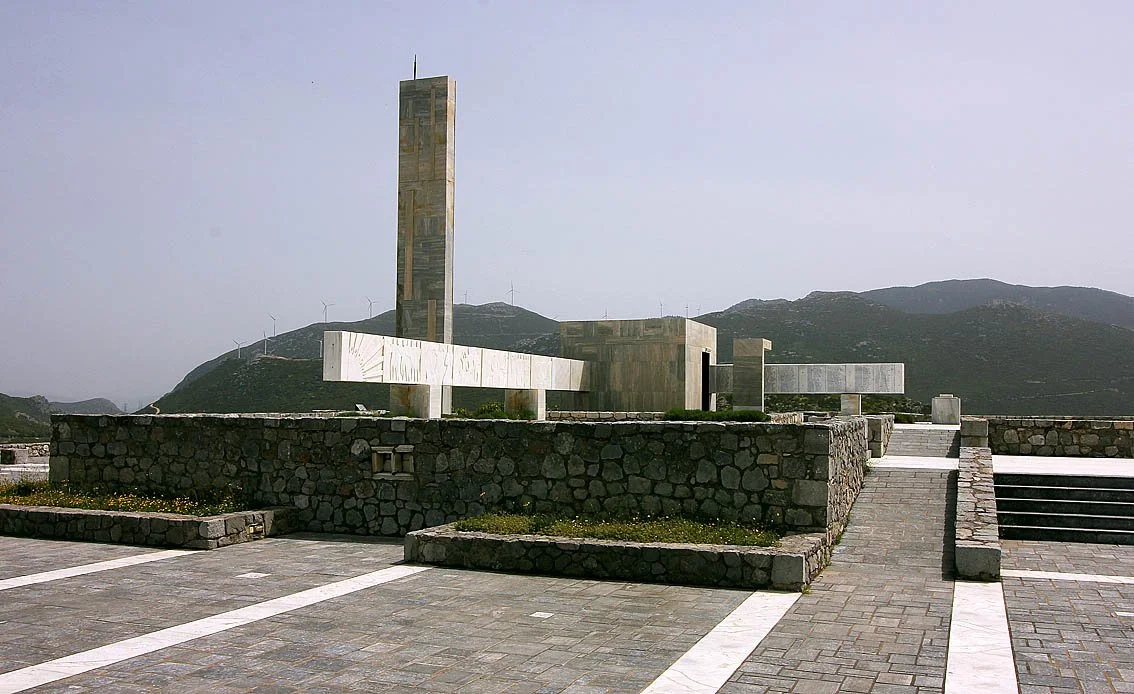
Linda Gasparello: Postcards from Greece -- joyous and tragic
Distomo, Greece — site of great beauty and great barbarity
I know -- through my education and experience -- the Latin phrase, “In vino veritas.” But until recently, I didn’t know the Latins lifted it from Alceus of Mytilene, a 6th-Century BC lyric poet from the Greek island of Lesbos, who said, “Wine, window into a man.”
Alceus was a contemporary of Sappho, known as the “Tenth Muse” and “The Poetess.” Scholars believe they exchanged poems and ideas – and, as both were Lesbian aristocrats, quite possibly they shared many amphorae of wine.
According to scholars, Alceus was involved in politics and frequented the fine wine-tasting events of the time: orgies.
In late October, as my husband Llewellyn King and I traveled north by bus from Athens International Airport to Eretria, a port town on the island of Evia, I tried to decode the some of the technicolored tags on the wall of the suburban railway that runs alongside the highway. There was one repeated tag in all caps that I, or anyone, could decipher: ORGY.
We were enroute to the Association of European Journalists (AEJ) annual congress, and the tag reminded me of Nora Ephron’s quip, “Working as a journalist is exactly like being a wallflower at an orgy.”
Greek Wine: It Is Drinking Better
Retsina, retsina, everywhere, but I didn’t drink a drop of it in Evia, which is one of the three major production centers of the resin-infused wine.
Isaia Tsaousidou, AEJ international president, and president of the Greek section, who organized this year’s congress, wanted to acquaint us with some of the excellent single-varietal and blended wines from Evia. She arranged a tour and lunch (an al fresco, typical Greek lunch of salad, pasta, grilled meats, French fries and very drinkable red and white wines) at the family owned Lykos Winery.
Enologist Vicky Avramidou Vassiliki told journalists that Lykos wines are made with Greek and international varietals, grown on Evia and the mainland. “Our Kratistos, a red wine made from 100 percent Agiorgitko grapes, and Malagousia, a white wine made from 100 percent Malagousia grapes, are very popular,” she said, adding that the bottling of Malagousia vintage 2022 has started.
In the Lycos Winery
The winery is decorated with wine barrels brightly painted with the wisdom of ancient and other sages.
Lykos means “wolf” in Greek, and the winery’s logo depicts the silhouette of a wolf howling at the full moon. One decorative barrel has the image of Little Red Riding Hood cuddling a wolf.
The winery, which is medium-sized, exports 50 percent of its production to the European Union, China, Japan, some U.S. states (North Carolina and New York are two) and Canada. Its wines range in price from 7 euros to “premium.”
There is a Greek saying that “Wine pleases the heart.” It also pleases the face: The winery now has a cosmetic line made from grape seed oil, which contains polyphenols. These plant compounds have been known to not just slow the aging process, but reverse signs of aging, like sun spots, fine lines, and wrinkles. Pip pip hooray!
All You Need Is Love
On the grounds of the Miramare, the seaside hotel in Eretria where the AEJ was holding its congress, I noticed an elderly man who I thought was headed to a local bocce match. He sported a white fedora trimmed with a black-and-white ribbon, a white shirt, and white pants.
Turns out, Nicos Papapostolou is a philanthropist and honorary member of the association’s Greek section.
At the opening session of the congress, he spoke about the Kaith Papapostolou Foundation, a charity which he founded in memory of his late wife. The foundation’s work is based on “charitable love” and supporting others in need, whether emotionally or materially.
The group’s latest effort is a 2022 calendar card, which asks, “Did I offer love today?” Every seventh day of a month is highlighted in red. On those days, “Double the happy, the one who offers!”
As translated, Papapostolou told the congress, “Our organization is imagining a society that feels its need for the right to be happy. … We want to remind people of the need of the government that people should be happy.”
Interestingly, the ancient Greeks didn’t believe that the purpose of life was to be happy but to achieve. Eudaimonia, a word used by Aristotle and Plato, is best translated as “fulfillment.” And Aristotle believed that citizens must actively participate in politics if they are to be happy — i.e., fulfilled — and virtuous.
At the Distomo Museum
Those attending this year’s AEJ congress in Central Greece had the chance to visit both the glorious museum at Delphi, the site of The Oracle, and the grim one at nearby Distomo, where the whole village was slaughtered by the Nazis in a few hours on a June.
The Distomo Museum of the Nazi Victims of June 10, 1944, contains a photos of the victims and paintings of the massacre — a large, Guernica-like one hangs in one of the rooms.
At the museum entrance, there is a blown-up photo of Maria Padiska, who has come to be known as the "Woman of Distomo,” and who died in March 2009 at the age of 84.
Her image became a world symbol of grief since the publication of an article in LIFE magazine, “What the Germans did to Greece,” on Nov. 27, 1944. The photo caption reads, "Maria Padiska still weeps, four months after the Germans killed her mother in a massacre at the Greek town of Distomo.”
Our visit to this museum was as gut-wrenching, as the documentary on Ukraine, filmed by Greek journalist Lena Kyropoulos, that we were to watch later at the congress.
The visit to the Distomo museum and the viewing of the documentary proved Winston Churchill’s point movingly, “The farther backward you can look, the farther forward you are likely to see.”
Linda Gasparello is co-host and producer of White House Chronicle, on PBS. She’s based in Rhode Island and Washington, D.C.
Llewellyn King: Sites of mass murder past and present; ‘what would I do?’
Memorial of the Distomo Massacre
— Photo by Dawetie
ERETRIA, Greece
The sites of horror -- the places where mass murder happened -- are seared into my memory. Holocaust sites such as the Warsaw Ghetto and Auschwitz or Kigali, where the Hutus butchered the Tutus, or the Falls Road in Belfast, where many died over the decades of strife.
A new one has just been fixed firmly in my memory: Distomo.
These sites of slaughter trigger the sense of how fragile human society is – and such slaughter is taking place this day, this hour, this minute in Ukraine.
I am not enthralled by history per se. My lens is mostly confined to what happened in my lifetime, whether as a small child during World War II or in the years since.
But the horrors of the past aren’t confined in the past. They leak into the present as new bleak chapters on human conduct are written.
I say this because I have just visited Distomo, where barbarity reached a crescendo on June 10, 1944. There, for two hours, the Waffen-SS killed villagers with machine guns, bayonets and any other handy weapons. They killed the unborn, infants and older children, women and men. They beheaded the village priest.
If they paused, it was to rape.
The Association of European Journalists, the 60-year-old organization with sections spread across Europe, had invited me to its annual congress in central Greece. After two busloads of delegates had visited the Oracle at Delphi, we stopped at Distomo: a trip from the celestial to the bestial.
My mind is set afire with questions at these World War II sites. If I had been a young Jew, swept up by the Nazis, would I have been killed in a camp? If I had been a young German guard, would I have participated in the killing, and how much enthusiasm would I have brought to the work?
I wonder how the young men who did the butchery at Distomo lived with themselves afterward. Did they dream of bayonetting pregnant women, of old people begging to be killed instead of their spouses, children and grandchildren?
In the end, few were spared -- only those who were left for dead. Conservative estimates are that 238 people died in the massacre.
My journalistic colleagues and I went from the foibles of the Greek gods of antiquity to the horrors of humans in the 20th Century.
I was just a child during World War II, but I feel especially connected because this and other Nazi atrocities happened in my lifetime.
When I visited Auschwitz and saw the hair, the shoes, the toys and other jetsam of children, my thought wasn’t that it could have been me, but that those could have been my friends, my playmates and every Jew I have been close to, and there have been many.
At the Distomo museum, they show a graphic film with eyewitness accounts of those who survived, those who bore witness, such as the woman who describes scooping the brains back into her dead toddler’s head and carrying his corpse home -- but her house, and nearly all those in the village, was burned by the SS. That is what she did and lived to tell -- to tell of that butchered child. She said in the film that she couldn’t forgive. Who with that memory could?
The young men who carried out the Distomo killings, under their 26-year-old leader, SS-Hauptsturmfurer Fritz Lautenbach, did so in reprisal for partisan attacks on German troops.
After visiting many killing fields – and I don’t seek them out -- I wonder what I would have done? Would I have followed orders? Would I, in seconds, persuade myself that what I was doing was right?
What would I do if I were on the Russian frontlines in Ukraine today? There is savagery equal to Distomo going on right now in wars in many places, carried out by people just like us.
Llewellyn King is executive producer and host of White House Chronicle, on PBS. His email is llewellynking1@gmail.com and he’s based in Rhode Island and Washington, D.C.
Linda Gasparello
Co-host and Producer
"White House Chronicle" on PBS
Mobile: (202) 441-2703
Website: whchronicle.com
ReplyReply allForward





